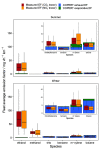Unreported VOC Emissions from Road Transport Including from Electric Vehicles
- PMID: 37191998
- PMCID: PMC10233797
- DOI: 10.1021/acs.est.3c00845
Unreported VOC Emissions from Road Transport Including from Electric Vehicles
Abstract
There are widespread policy assumptions that the phase-out of gasoline and diesel internal combustion engines will over time lead to much reduced emissions of Volatile Organic Compounds (VOCs) from road transport and related fuels. However, the use of real-world emissions measurements from a new mobile air quality monitoring station demonstrated a large underestimation of alcohol-based species in road transport emissions inventories. Scaling of industry sales statistics enabled the discrepancy to be attributed to the use of ancillary solvent products such as screenwash and deicer which are not included in internationally applied vehicle emission methodologies. A fleet average nonfuel nonexhaust VOC emission factor of 58 ± 39 mg veh-1 km-1 was calculated for the missing source, which is greater than the total of all VOCs emitted from vehicle exhausts and their associated evaporative fuel losses. These emissions are independent of the vehicle energy/propulsion system and therefore applicable to all road vehicle types including those with battery-electric powertrains. In contrast to predictions, vehicle VOC emissions may actually increase given a predicted growth in total vehicle kilometers driven in a future electrified fleet and will undergo a complete VOC respeciation due to the source change.
Keywords: air pollution; ethanol; screenwash; urban atmosphere; volatile chemical products.
Conflict of interest statement
The authors declare no competing financial interest.
Figures





References
-
- McDonald B. C.; de Gouw J. A.; Gilman J. B.; Jathar S. H.; Akherati A.; Cappa C. D.; Jimenez J. L.; Lee-Taylor J.; Hayes P. L.; McKeen S. A.; Cui Y. Y.; Kim S.-W.; Gentner D. R.; Isaacman-VanWertz G.; Goldstein A. H.; Harley R. A.; Frost G. J.; Roberts J. M.; Ryerson T. B.; Trainer M. Volatile chemical products emerging as largest petrochemical source of urban organic emissions. Science 2018, 359, 760–764. 10.1126/science.aaq0524. - DOI - PubMed
-
- Timmers V. R.; Achten P. A. Non-exhaust PM emissions from electric vehicles. Atmos. Environ. 2016, 134, 10–17. 10.1016/j.atmosenv.2016.03.017. - DOI
-
- Lewis A. C.; Hopkins J. R.; Carslaw D. C.; Hamilton J. F.; Nelson B. S.; Stewart G.; Dernie J.; Passant N.; Murrells T. An increasing role for solvent emissions and implications for future measurements of volatile organic compounds. Philos. Trans. R. Soc. A 2020, 378, 20190328.10.1098/rsta.2019.0328. - DOI - PMC - PubMed
-
- Winkler S. L.; Anderson J. E.; Garza L.; Ruona W. C.; Vogt R.; Wallington T. J. Vehicle criteria pollutant (PM, NOx, CO, HCs) emissions: how low should we go?. npj Clim. Atmos. Sci. 2018, 1, 1–5. 10.1038/s41612-018-0037-5. - DOI
Publication types
MeSH terms
Substances
LinkOut - more resources
Full Text Sources
Medical

